











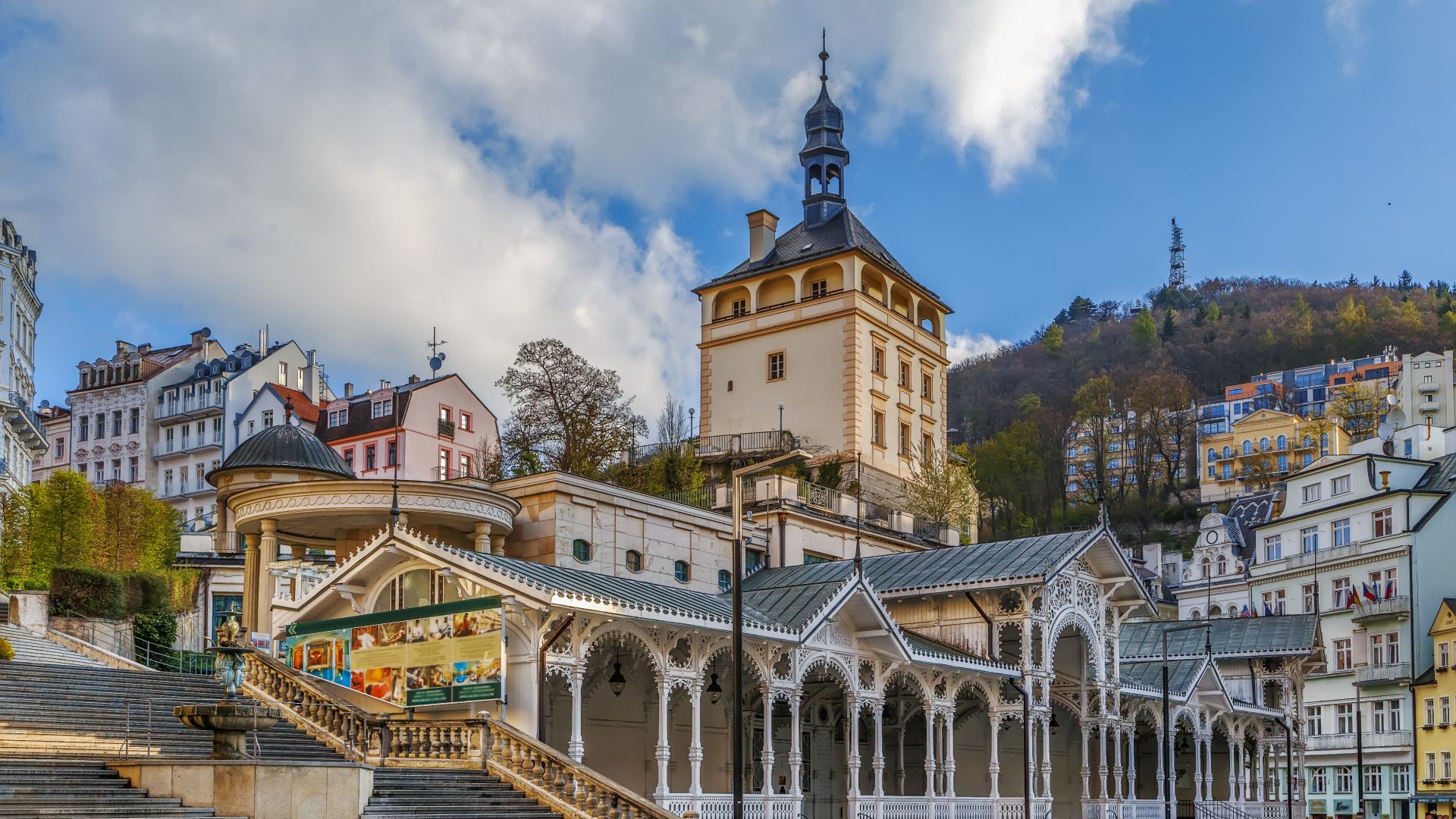
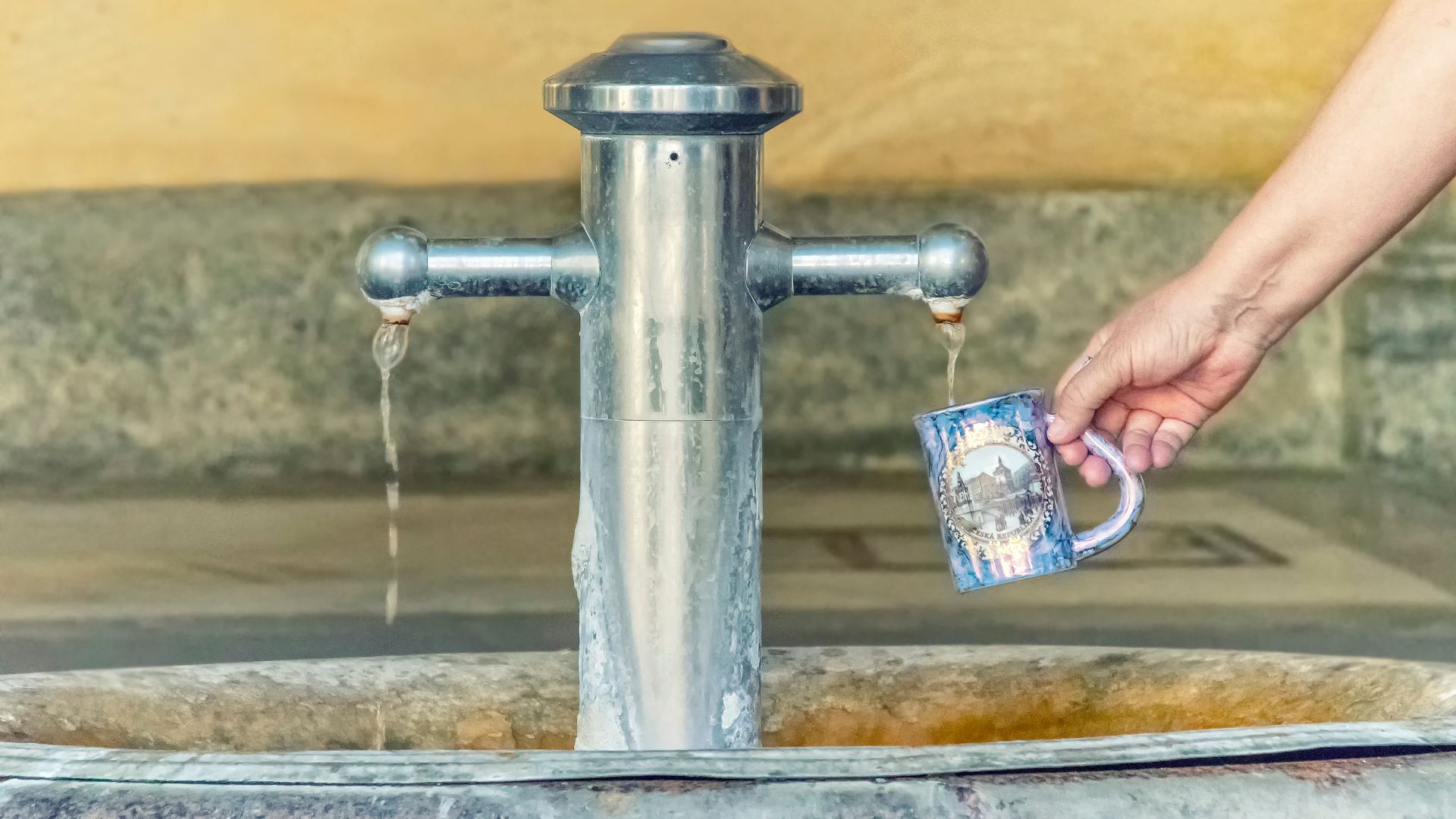
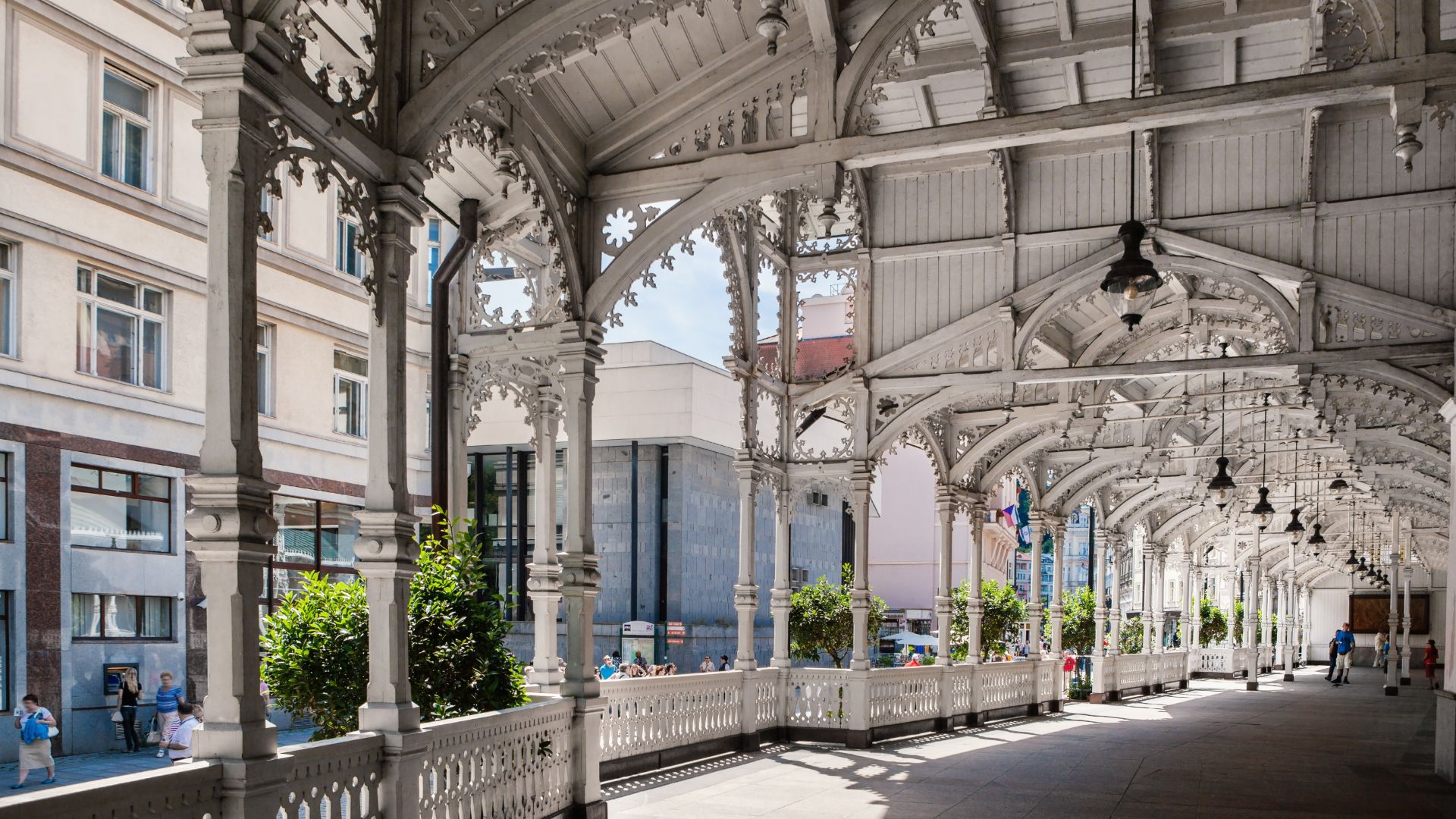
Take a trip from Prague to Karlovy Vary, the most famous spa in the Czech Republic, and explore this charming town at your own pace! A comfortable bus will take you directly from Prague to Karlovy Vary, where you will have 5 hours of free time to explore. With an audio guide in your headphones, you can learn about the healing springs, rich history, and iconic sights such as Vřídlo, the colonnades, and the famous Moser glassworks.
Let yourself be enchanted by the unique atmosphere of Karlovy Vary. Stroll through its picturesque spa streets, taste the traditional mineral springs, and enjoy the renowned Karlovy Vary wafers. With PREMIANT eGuide, you can plan your day as you wish. Visit the Diana Tower for spectacular views, explore the Becherovka museum, or even pamper yourself at one of the town’s historic spas.
After a day of exploration, you will comfortably return to Prague. This Karlovy Vary day trip from Prague is ideal for anyone who wants to visit Karlovy Vary and experience the town without the need for a guided tour, yet still have all the essential information at hand.
As a gift from us, you will receive a ticket to the Railway Kingdom in Prague (can be used anytime after the tour).
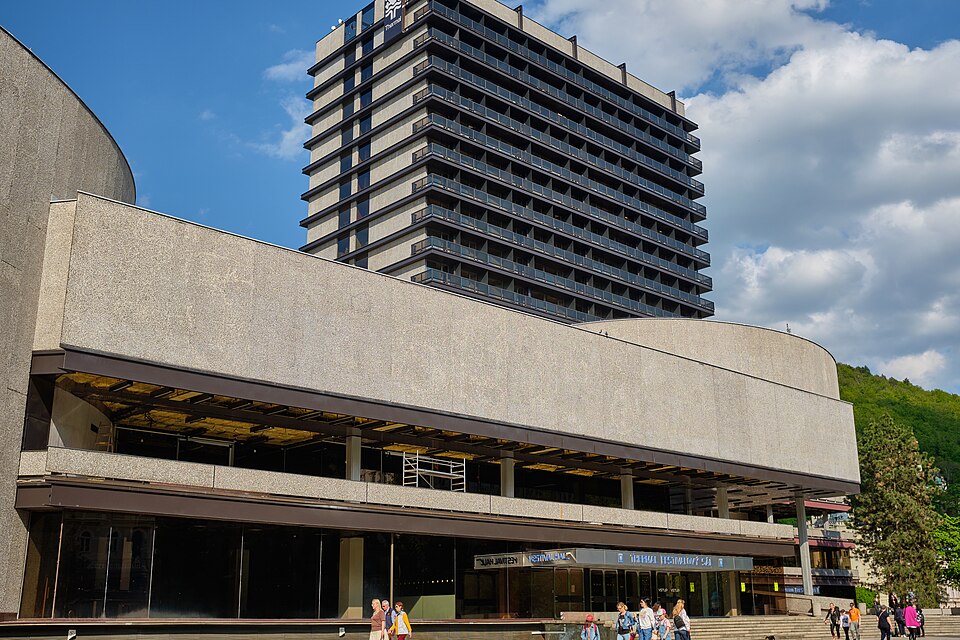
Hotel Thermal is a high-rise building built in the nineteen sixties, acting as the gateway to the spa centre. The Machonin couple created the project in the style of brutalism. Thirty Art Nouveau buildings from the nineteenth century had to make way for the project. This complex also includes a festival cinema for two hundred thousand viewers and five conference and projection halls for two thousand visitors. The dominant feature is a sixty-metre tall reinforced concrete structure. The thermal swimming pool situated on a cliff above the hotel is highly popular. Among other things, the pool and cafe boast an enchanting view of the whole spa centre. A pleasant walkway from the back side of the hotel leads there. Hotel Thermal is the main base of the international film festival, hosting the opening and closing ceremonies and the awarding of the festival prizes, the Crystal Globes.
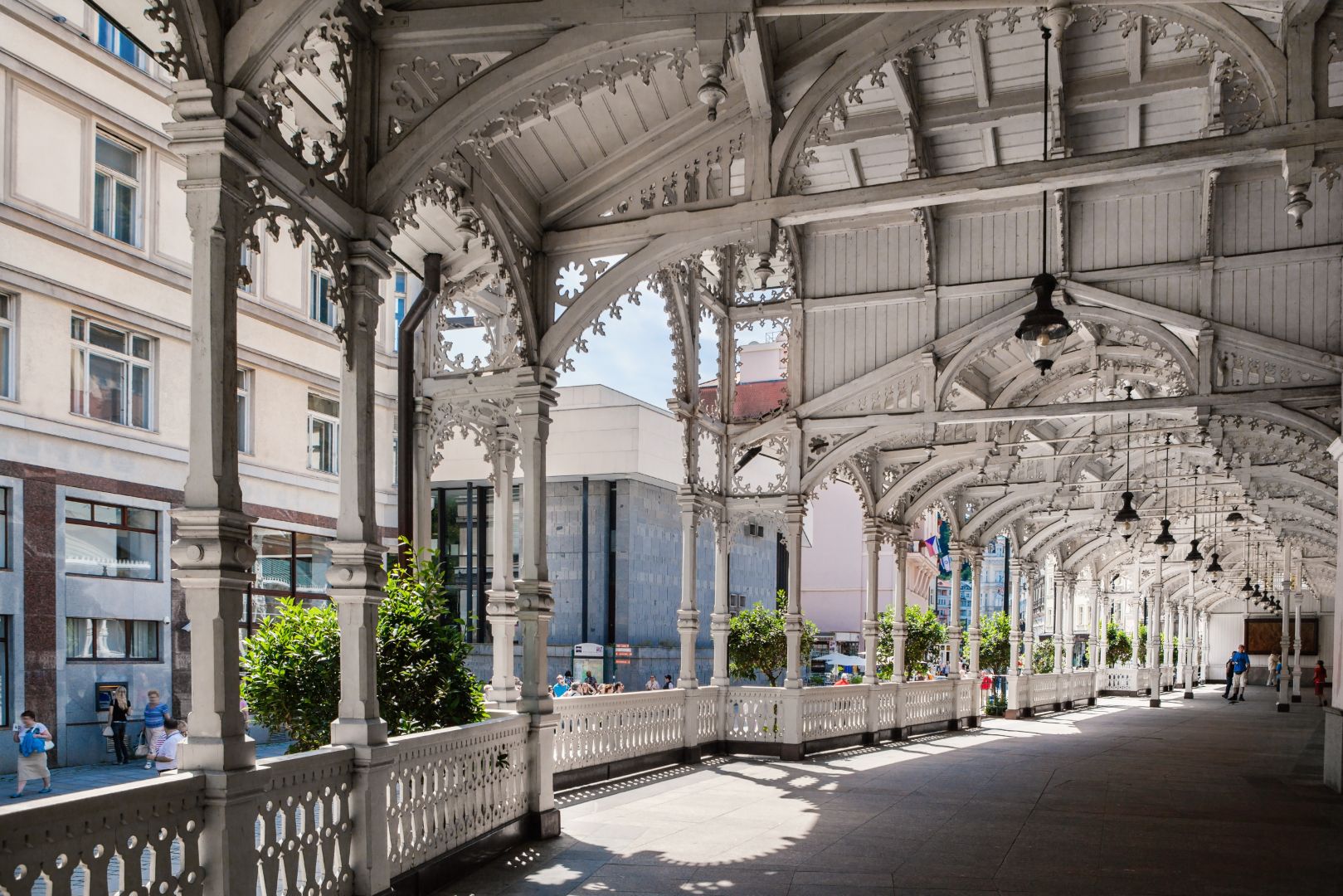
The Park Colonnade – Hadí pramen is found near the Antonín Dvořák Park, where this important musical composer also has a statue. He himself visited Karlovy Vary often and gladly. The Sadový pramen (Park Spring) offers our first taste of the thermal mineral water. You can drink it from a special spa mug that can be bought at many local shops and souvenir stands. It is special in that it has a porcelain straw in order to avoid burning one's tongue. The water is very hot. The temperature of the springs ranges between thirty and eighty degrees. The water jets out at the end of the gorgeous cast-iron colonnade, which is the work of famous Viennese architects Fellner and Helmer from the end of the nineteenth century. At each spring we find its name and the water temperature. With mug in hand we can promenade on through the city to the other springs. This one is only thirty degrees, but has a greater amount of carbon dioxide.
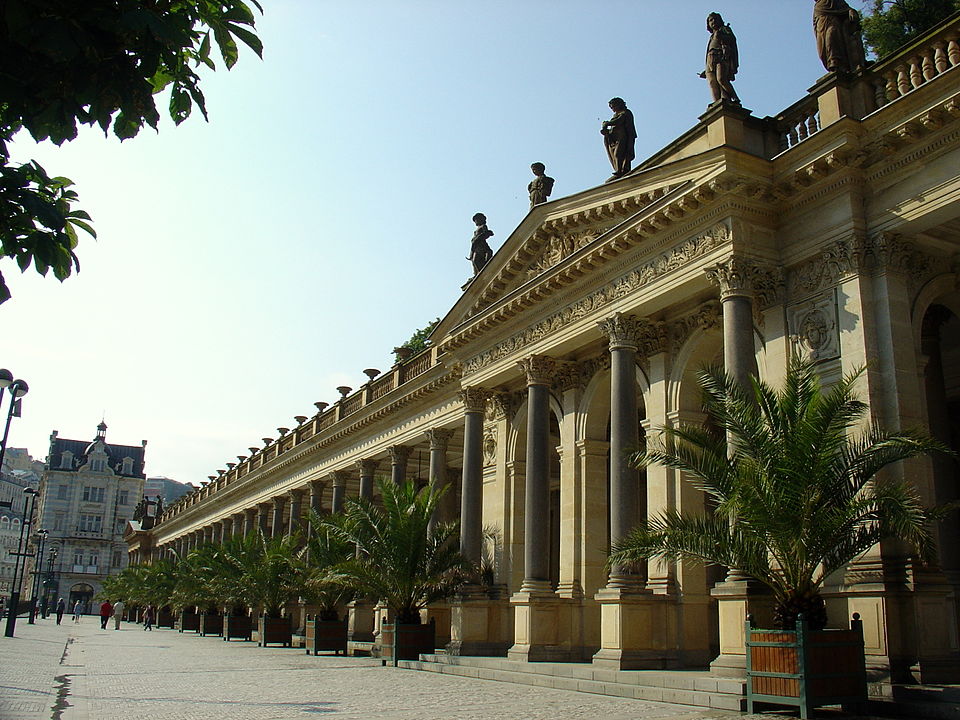
The Mill Colonnade adjoins the spring Svoboda (Freedom), which stands alone under a white gazebo. Here we can also sample the hot mineral water. We continue along the Mill Colonnade, which is the largest and most attractive colonnade in Karlovy Vary. It was built in the Neo-Renaissance style at the end of the nineteenth century. It is one hundred and thirty metres long and its roof is borne by one hundred twenty four Corinthian columns. the upper terrace is decorated by twenty statues, which are allegories for the months of the year. The terrace is open to the public. In the summer months the colonnade is also used as a concert venue. The music makes the stay of spa guests as well as tourists more enjoyable. The Mill Colonnade covers five different springs. A bust of Josef Zitek, who designed the whole structure, is located near the Mill Spring. Once again we can fill our mugs with the various waters and relax on the benches in front of the colonnade, or watch the trout in the river Teplá. On the opposite bank, among the other buildings, we can see a small house decorated in red, which is the oldest preserved Baroque building in the city. The Peter House, originally called U zlatého vola (At the Golden Ox), was built at the start of the eighteenth century. The owner received a permit to use the house to accommodate tourists and serve food. At the end of the nineteenth century the first cinema cafe was built here following renovations. Now it is a casino.

The Market Colonnade covers the springs Karla Čtvrtého (Charles the Fourth), Dolní zámecký (Lower Castle), and Tržní (Market). It is heavily carved, with an open structure, built in the Swiss style. It was built where the oldest Karlovy Vary spa originally stood. According to legend, the emperor himself treated his sick limbs by the Charles the Fourth Spring. Originally the springs were covered with a simple gazebo and a promenade hall. The Market Colonnade was built in place of the old Karlovy Vary Town Hall as the third of the four current Karlovy Vary colonnades. The temporary structure, built due to a lack of funding for Fellner and Helmer's project for a period of a mere ten years, continues to serve its purpose to date. In the left wing of the colonnade above the spring is a wood relief carving that captures the legend of how the thermal springs were discovered. Across from the Market Colonnade we see the modern structure of the Hot Spring Colonnade and the Church of St Mary Magdalene.

The Church of St Mary Magdalene, originally surrounded by a cemetery, was built in the second half of the fourteenth century on a rise above the Hot Spring Colonnade in the middle of Karlovy Vary. Later it was renovated in the Renaissance style. After several fires it was in very poor condition, thus it was torn down and a new church was built in the first half of the eighteenth century. Inside the church you can view the richly decorated Baroque fixtures from the eighteenth century. Worthy of attention in the underground portion of the church is the unique burial crypt of the original Gothic church, in which the skeletal remains of the former cemetery are interred. The church is open to the public only during religious services.

The spring on the Hot Spring Colonnade emerges from two kilometres below the surface and the geyser stretches up as high as twelve metres. It is the most powerful spring in Karlovy Vary. It used to be that only light shelters and pavilions stood above the spring of Vřídlo (Hot Spring), as they could be easily replaced following the repeated explosions and surprising gushes from the thermal spring. In the eighteenth century the large Baroque Vřídelní sál (Hot Spring Hall) was built nearby, reflecting the application of the treatment principles of David Becher, which emphasised drinking water directly by the spring. At the end of the nineteenth century a new cast-iron Hot Spring Colonnade was built in its place in a pseudo-Renaissance style, also based on the design of Viennese architects Ferdinand Fellner and Hermann Helmer. At the start of the Second World War however, the corroded colonnade structure was dismantled and for the next twenty-seven years it was replaced by a makeshift wooden replacement. The current brutalist form of the Hot Spring Colonnade comes from the seventies. The Hot Spring Colonnade also covers another four springs of varying temperatures, as well as shops with ceramics and other spa products. There is also a restaurant with a cafe and public washrooms here. Hot spa wafers are sold in the foyer. From time to time various exhibitions take place in the Hot Spring Colonnade. The Hot Spring Colonnade is positioned as a bridge over the river Teplá and in the depths of the colonnade there are areas accessible to the public where the "Karlovy Vary Rose" is formed due to sedimentation of the hot spring minerals. A tour of the underground must be ordered in advance. Part of this colonnade is under renovation, thus the Hot Spring has been shifted outside under the open air.
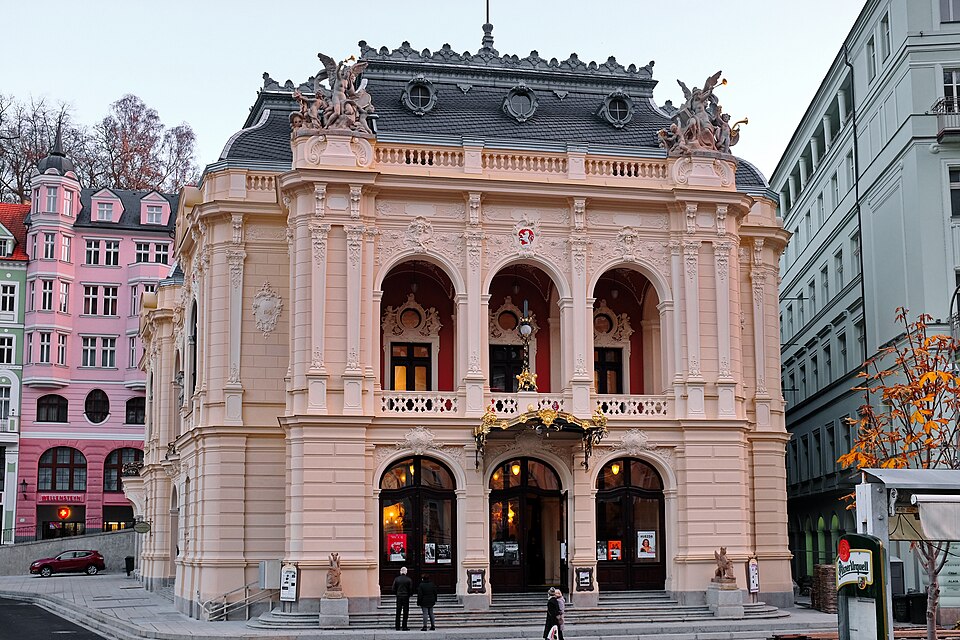
The first building of the Municipal Theatre in Karlovy Vary, entitled the "Comoedi Haus", used to stand at the site of today's Grandhotel Pupp. It was a roughly forty-metre long structure made of boards and reeds that functioned as the summer stage for Italian opera companies before it collapsed during a performance. The foundation stone of the first brick theatre in Karlovy Vary was laid at the end of the eighteenth century. Construction was initiated and funded by Doctor David Becher. The first performance was Mozart's opera The Marriage of Figaro. The Becher Theatre (or "Schauspielhaus"), as it was called, was located at the site of today's Municipal Theatre. Eighteen managing directors took turns at the helm, the most famous of them being Josef Lutz, who presented even the most demanding of operas with success. The theatre began to run up against further technical and hygienic problems however, and had to be closed down. The creation of another theatre was plagued by technical problems and delays concerning the building plot, and then the construction tender was even cancelled. This tricky situation was further complicated by the fires of the National Theatre in Prague, the theatre in Vienna and even a fire of the old Karlovy Vary theatre. For this reason the designs had to be reworked so as to meet stricter safety regulations. The new theatre building was built at the end of the nineteenth century in a pseudo-Rococo style by architects Ferninand Fellner and Hermann Helmer. A completely new element was the installation of electricity, allowing for better lighting and ventilation. Today the theatre has a capacity of seven hundred audience members.
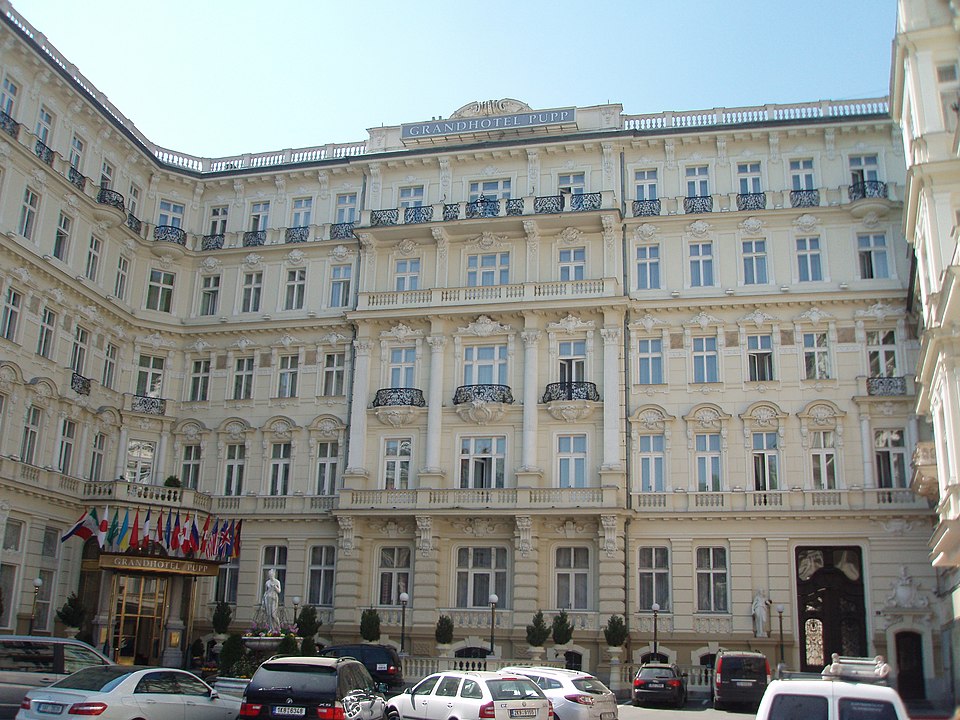
Grandhotel Pupp is the most prestigious hotel in Karlovy Vary with a capacity of over two hundred beds. Two mayors of Karlovy Vary made a mark in the history of the hotel. The first of them, Anton Deiml, built the Saský sál (Saxon Hall) in the year seventeen hundred, receiving that name because the Elector of Saxony Friedrich August contributed to the construction. Seven years after it was completed, a different Karlovy Vary mayor, Andreas Wenzel Becher, had the competing Becheres Lusthaus built on the neighbouring lot. It was called the Český sál (Bohemian Hall) after the seasonal waiters from Prague. Sixty years later, confectioner Jan Jiří Pop, who later started to sign his name Johann Georg Pupp, came to Karlovy Vary to work under local confectioner Mitterbach. Pupp then married Mitterbach's daughter Francisca. The married couple made good use of the dowry. They gradually bought up the Bohemian Hall from the Becher family. Eighty years later, Pupp's family also purchased the other building, the Saxon Hall, and their descendants later bought up the rest of the surrounding lots. The halls were then rebuilt into the Parkhotel, which was subsequently expanded with another addition. At the end of the nineteenth century, construction began on the Grandhotel Pupp based on the design of Viennese architects Příhoda and Němeček, not Fellner and Helmer as is often mistakenly claimed. Over the following two years the complex of buildings was completed. The last pre-war modification took place in the year ninety thirty-seven. From the autumn, after the Sudetenland was annexed to Germany, the hotel presented itself as Grand- und Park- Hotel Pupp. After the Second World War the hotel was nationalised and with the confiscation the family history of the Pupps in Karlovy Vary ended. In the nineteen fifties it was renamed the Grandhotel Moskva (Grandhotel Moscow). In the year ninety fifty-seven it was listed in several advertising materials as Grandhotel Moskva – Čedok, as two years previously it had come under the administration of Čedok, which was the largest travel agency during socialism. Only a few days after the start of the Velvet Revolution, the Grandhotel Moskva sign was removed from the facade and replaced with the traditional Grandhotel Pupp. Subsequently preparations were begun to transform the hotel from a state enterprise to a joint-stock company. In just under two years a settlement was made with the heirs of the Pupp family to use the traditional name Grandhotel Pupp, and under this name it continues to spread this hotel's fame around the world. Thousands of famous people have resided in the Grandhotel Pupp over its long history, for example: composers Johann Sebastian Bach, Ludwig van Beethoven and Richard Wagner, Russian Tsar Peter the Great, Austrian Empress Maria Theresa, English King Edward VII, Spanish King Juan Carlos the First, Norwegian King Harald the Fifth, actors Michael Douglas, Ornella Muti, Claudia Cardinal and Danny DeVito, as well as Otto von Bismarck, Napoleon Bonaparte, Franz Kafka, Giacomo Casanova, Karl Marx, Yuriy Gagarin, Jaromír Jágr, Antonio Banderas, Renée Zellweger, John Malkovich, John Travolta and more.
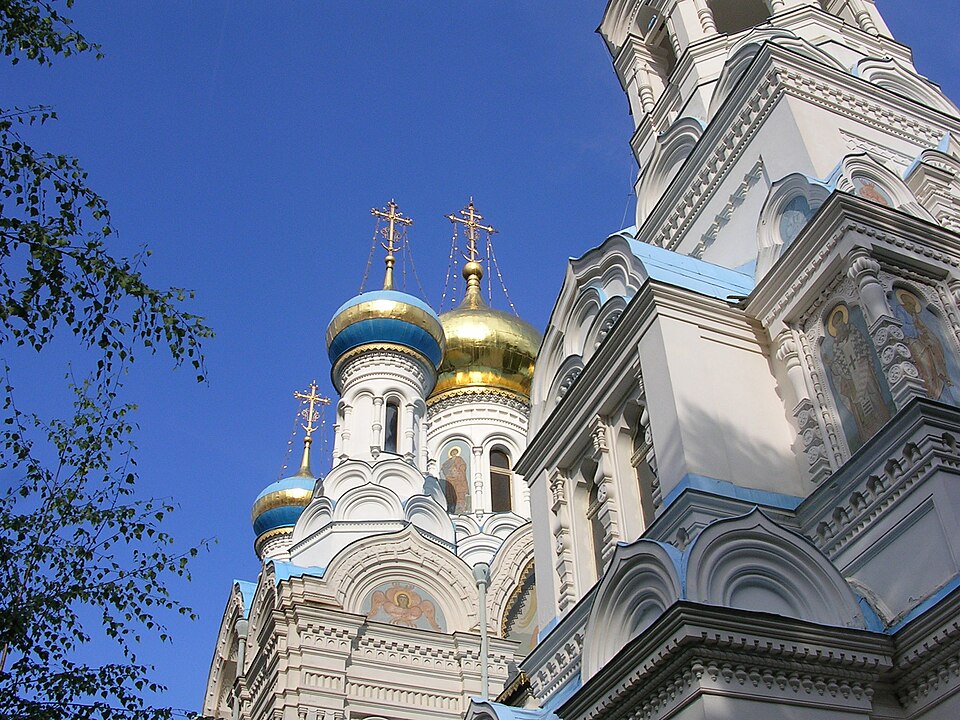
This Orthodox church is a fascinating ecclesiastical structure from the end of the nineteenth century that is part of the Westend villa neighbourhood, not far from Hadí pramen (Snake Spring). It is built based on a church in Ostankino near Moscow. It was financed by the Serbian and Russian spa clientele and nobility and was built at the site of a former Orthodox chapel. It is also the oldest and most important Orthodox church in the country. It has the layout of a Greek cross, and its five gilded domes cannot be missed even from far-off. Its saddest period was during the Second World War, when it served as a warehouse.
An unforgettable experience with Premiant City Tour






